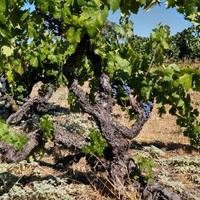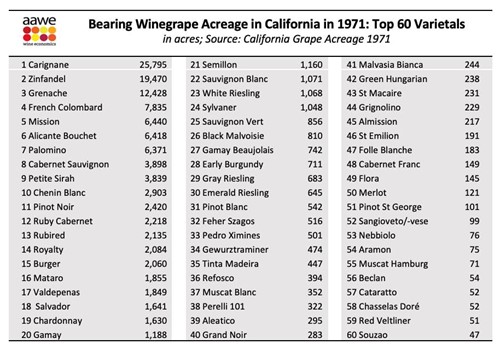Vino In My Dino
Acres of History
February 14, 2022 11:27

By now you should be familiar with my MO if you have been reading my posts for a while. I love history, I enjoy digging through old documents and files, and find nothing is more fun than diving into the California Department of Water Resources and educating myself about this all important component of farming. In January Karl Storchmann, for the American Association of Wine Economists, posted this and caught my eye-the 1971 Grape Acreage for California. Pure gold for this grape and history loving gal.

Let's take a look at what was happening in 1971. Dirty Harry and Billy Jack were dominating the cinema, Elon Musk and Snoop Dog were born, the first Starbucks coffee shop opened in Seattle as did Disney World in Orlando. Gas was 36 cents a gallon and Rod Stewart was singing Maggie May on the radio. In Sonoma County the grape and wine business was just beginning to enjoy a renaissance after being shut down by Prohibition. It took 40 years to recover and open up to a new generation of vineyards and wineries. By the way I was 11 years old and living in our home in the midst of the winery operations, playing in the very vineyards that are tallied in this report.
Back to the state report. It is an annual one and I still reference it each time I do a talk on Zinfandel or need some information on how many acres of Cabernet are in production. As you can see by this 50 year old report Zinfandel was the second most planted wine grape at the time second only to Carignane (!). And one of the reasons there are old vine Zinfandel blocks around the state.
The history of grapes grown on our property goes back to the early 1900s when the original family planted Zinfandel and a variety of other grapes like Carignane and Petite Sirah and lesser known field blend varieties. The original 25 acres expanded to 100 acres today and grew exponentially with the market. We have had quite a mix of grapes over the years reflecting market preference or winemaker choice. Pinot Noir in the 1950s followed by Cabernet Sauvignon in 1965, Gewurztraminer, Riesling, Napa Gamay, Sauvignon Vert and French Colombard followed. Then Chardonnay, Merlot & Sauvignon Blanc in the 1980s; Petite Sirah, Syrah and Portuguese varieties in the 1990s; Petit Verdot and Malbec in the 2000s. They had their place in the market but things change just like the 1971 chart. What was once 19,470 acres of Zinfandel is now 40,061 and 3898 acres of Cabernet Sauvignon exploded to 94,854. Carignane, the leader back then, at 25,795 is now 2289. The one-two punch of the top two grapes planted today are Cabernet Sauvignon as noted above and Chardonnay (from 1630 to 92,311!).
Our flagship grape is steeped in this rich history not only in California but right here in Dry Creek Valley (which is home to half of all the Zinfandel planted in Sonoma County). The history in acreage throughout the state denotes what was popular at this snapshot in time. Over the last 5 decades some grapes survived (Zinfandel), some grew by leaps and bounds (King Cab) and others have faded away. We also learned which grape suits our vineyard microclimates and subsequently discovered Pinot Noir and Chardonnay do much better a few miles south of us. This glimpse of history is important because, like hit songs and blockbuster movies from 50 years ago, even wine grapes continue to stand the test of time.
Categories
- COVID
- Follow the Vineyard
- Note from Home
- PairItWithPed
- Pandemic
- pedroncelli
- Port
- Postcards from Home
- Pruning
- Seasons in The Cellar
- Tasting Room
- Thanksgiving
- Vintage Notes
- Winemaking
- Women's History Month
Recent posts
-
91 Years Later
-
Come Over October: It's About Community
-
Come Over October
-
A Legacy Continues!
-
Everything Old is New Again
Popular tags
- Cabernet Sauvignon
- Anniversary
- Dry Creek Valley
- 1974 Cabernet Sauvignon
- note from home
- American Oak
- Courage Zinfandel
- Sauvignon Blanc
- Easter
- Pandemic
- French Oak
- Pruning
- Pedroncelli
- Mother Clone
- Down to Earth
- Homecooking
- Estate Vineyard
- COVID Coffee Chat
- food and wine
- Recipes
- Barrels
- Rosé
- Holding steady
- Habit
- Lake Sonoma
- Pantry
- Sonoma County
- Four Grapes Port
- cheese
- OpenThatBottleNight
- Cellar Master
- Bushnell Vineyard
- Crop set
- Schotzki
- Reserve
- Harvest 2022
- COVID19
- Oak
- family
- Cookies
- Heat wave
- cooking with wine
- Follow the Vineyard
- newsletter
- Finding Your Roots
- Block 007 Cabernet Sauvignon
- Seasons in The Cellar
- Library Wine
- PairitwithPed
- Merlot





